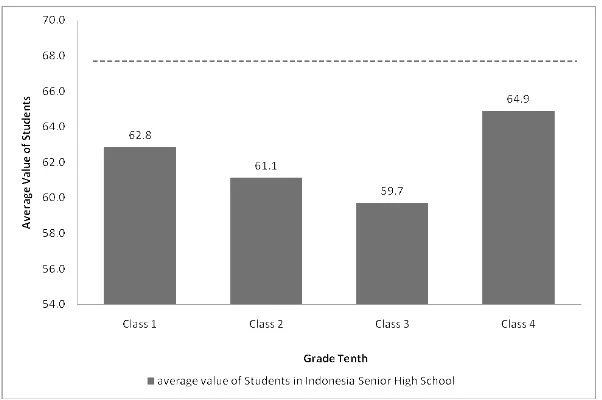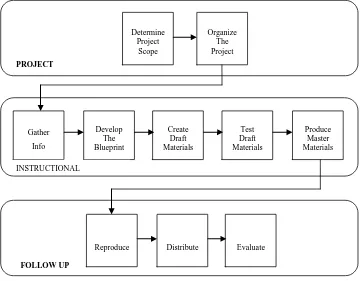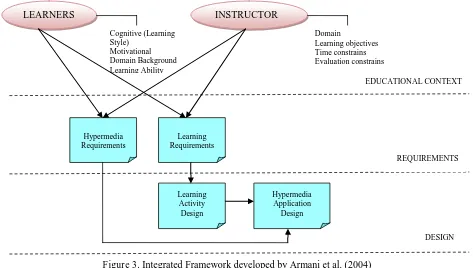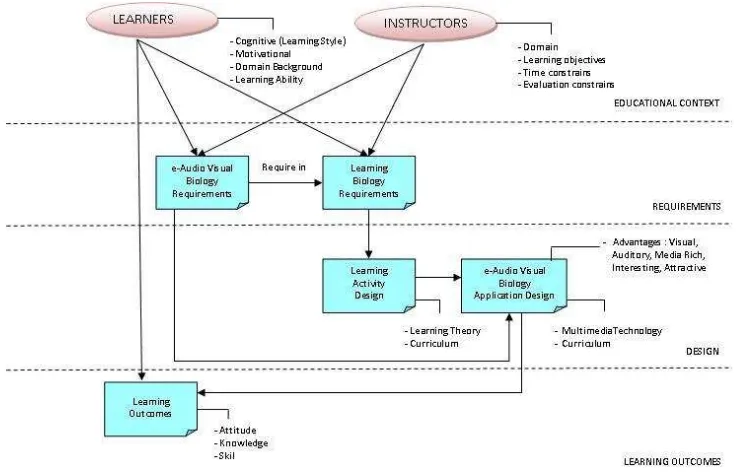1
THE PROPOSED CONCEPTUAL FRAMEWORK OF e-AUDIO VISUAL BIOLOGY
FOR TEACHING AND LEARNING IN INDONESIA SENIOR HIGH SCHOOLS
Siti Hadiati Nugraini
In Indonesia, Senior High Schools’ students who learn biology generally tend to memorize Biology contents. Most of the contents in Biology are abstract, loaded with a lot of
information and facts, which are beyond the learners’ observation and daily experiences.
These kinds of learning experiences have been observed as the cause of low enrolment and achievement in Biology classes. Moreover, the common teaching and learning activities such as listening, taking notes, doing individual assignments also cause low motivation in Biology.
In general, the students’ achievements are not able to meet the teachers’ intended standard.
This paper highlights the key elements of an innovative and integrated instructional framework for biology education. This paper explains the design and the possible development of a conceptual framework for Biology Teaching and Learning that can be used
to measure students’ motivation and learning outcomes. This framework is proposed within
the context of Biology education for Indonesian Senior High Schools.
This paper defines an e-Audio Visual framework dealing with both instructional design topics and, the design of computer-based application or Hypermedia design, addressing educational audio visual framework for Biology. The framework is described in four main levels of activities: The Educational Context Level, The Requirements Level, The Design Level and The Learning Outcomes Level. The details of these criteria will be explained.
Keywords: e-Audio Visual, Conceptual Framework, Biology, Learning Outcomes.
Introduction
This paper highlights the key elements of an innovative and integrated instructional framework for biology education in Indonesia Senior High Schools.
According to a preliminary observation in classrooms, we observed that many students in Indonesia have difficulties in learning biology. They thought that learning biology is just to memorize the subject, and they found it not interesting. Figure 1 shows a graph of the average grade value of biology of different classes, acquired through an informal survey in some classes at a Senior High School of Indonesia. The graph shows the standard grade value of the school in dashed-line, which are 68. However, the grade values of all classes are below the standard grade value (see Figure 1).
2
Figure 1. Class average values of Biology were not able to meet the standard grade value (Source: Based on an informal survey data in a Senior High School of Indonesia, 2009).
Explained by Setiawan (2008), many students in Indonesia did not have interest to learn biology and their participation in biology classes were low. This could be due to the reasons mentioned above such as low interest and low engagement in classes. In addition, the traditional teaching method is also the cause for the students to become passive.
Biology teachers should have the abilities to make learning atmosphere interesting and rewarding for the students. The teaching aids have been considered as an urgent necessity for the teacher to explain biology subject in the classroom. Sudjana and Ahmad (2005) stated that the roles of media in the teaching and learning process are getting more important in education.
Electronic Audio Visual (e-Audio Visual) biology media is one of the alternative aids for biology
classes, to bring more media elements and visualization into classrooms, and to improve students’ learning
experiences for biology. e-Audio Visual in this research means electronic Audio Visual and interactive Audio Visual. It is e-Learning which focuses more in audio and visual. e-Learning has become a trend in educational environment. The new wave of e-Learning brought to a complete integration of technologies in education. Educational Web sites have become an almost standard feature of a large part of Higher Education courses (Harasim, Hiltz, Turoff, & Teles, 1995). Internet Website can be used for delivering materials such as the syllabus, lecture slides, readings and assignments, shared learning space (for group work, interaction with the instructor or the tutor, or discussion forum), and also for organizing structured activities such as WebQuests (Dodge, 2003).
Instructional Design
Teaching or Instruction has been influenced by cognitive holistic psychology, which put the students as the source of the activities. Teaching is also influenced by the technology, facilitating the students to learn something using various media, such as printed materials, television, internet, pictures and audio, and others. All of those technology aspects could support the changing of teachers in managing the teaching and learning process, from the source of learning to the facilitator of teaching and learning process. Gagne’s (2005) stated
that teachers’ roles are more emphasized on how to design and arrange various sources and facilities provided
to be utilized by the students in learning something, such as biology.
A more formal and systematic ways of thinking about the teaching and learning process are explained by Rogers (2003) as follows:
The activities with the students in the classroom that enhance their new knowledge by using teaching media and allow them to practice with it
The evaluation programs that help students demonstrate their understanding
A Framework for the Instructional Design
Framework consists of “a conceptual map that identifies the channels and might influence teaching
practice and subsequently student learning, and a set of guiding questions that can be applied to various policies, programs, and practices within the system and to outside influences that may affect the education
3
interacting forces and conditions that affect teaching and learning.
Greer (1991 & 1992) describes Instructional Design (ID) process as the production of learning
material. The assumption behind Greer’s model is that ID is learning material design, or at least that the activities are developed as a part of the learning materials. Greer’s Model (1991 & 1992) is shown in Figure 2.
Figure 2. Greer’s Model.
The general point of Geer’s framework is that it defines a specific phase for material development, as
an advantage over traditional ID. Greer (1991 & 1992) stated that “Traditional ID models do not explain what
its connections with other phases are”. The Greer model is explained below:
The instructional design by Greer is the methods of instruction which contains learning materials and learning activities
There is a sequence of flow, for producing learning materials and learning activities
Yet, this instructional design does not explain about the teaching media
A Framework for Hypermedia Design
The Hypermedia Instructional Design explains about teaching media. The research on hypermedia design models stem from past results of software engineering, database and link, management system fields, merged with the peculiarities of a unique and multifaceted process such as the development of multimedia contents and navigation based interaction (Armani et al., 2004; Kampa et al., 2001).
Figure 3 sketches the integrated model by Armani et al. (2004). In this model, they propose to consider
three main levels of activities: “The Educational Context Level, The Requirements Level and The Design
Level” (Armani et al., 2004, p.3). Gather
Info
Determine Project
Scope
Create Draft Materials
Test Draft Materials
Produce Master Materials Develop
The Blueprint
Organize The Project
Reproduce Distribute Evaluate
PROJECT
INSTRUCTIONAL
4
Figure 3. Integrated Framework developed by Armani et al. (2004)
e-Audio Visual Biology Integrated Framework
e-Audio Visual Framework in this paper was adapted from Armani’s Integrated Framework. We describe four main levels of activities, as shown in Figure 6: The Educational Context Level, the Requirements Level, the Design Level, and the Learning Outcomes Level. We will explain these levels and their connections. The following paragraphs are to explain this framework:
The Educational Context Level consists of all the traditional elements, grouped in two sets: learners and instructors. The learners have these elements: the learning styles, motivational aspects, the domain background and learning abilities, while the instructors have these four elements: the Domain, the Learning Objectives, Time/Space constrains, and Evaluation constrains. In the case of Biology teaching and learning in Indonesia, the Education Context Level has to be designed using the respective situation of the students and teachers. The data from the educational context level, especially from two set— learners and instructors, will be used in the Requirements level.
The Requirements Level will influence the Design Level. The e-Audio Visual Biology Requirements will influence e-Audio Visual Biology Application Design, while the Learning Biology will influence Learning Activity Design. All of the three levels—educational context, Requirements, and design—will simultaneously influence Leaning Outcomes Level consisting attitude, knowledge and skill of the students.
The Educational Context Level
The learners include four elements: the learning styles, motivational aspects, the domain background and learning abilities (Armani et al., 2004), as follows:
1. The learning styles, preferred modes of perceiving and processing information.
2. Motivational aspects, i.e. the perceived importance of the instruction and the perceived possibility of success.
3. The domain background, i.e. the previous knowledge that the learners have of the specific content to be taught.
4. Learning abilities, i.e. how learners are able to learn by themselves or with specific learning materials, respectively how much guidance they need.
The instructors include four elements: The Domain, The Learning objective, Time/space constrains and Evaluation constrains (Armani et al., 2004):
1. The Domain is an indication of the specific content of the instruction. This might range from a simple indication of the discipline (e.g. literature) to a more detailed “editorial plan” and a specification of the information sources (books, course notes, etc).
2. The Learning objective is a statement of the goals of the instruction, i.e. a description of what the learners should know or be able to do after they completed the activities. Goals can be defined
5
et al., 1950 cited in Armani et al. 2004). Anderson & Krathwohl’s taxonomy (2001), revising Bloom’s taxonomy, can also be used for classifying the goals by its type.
3. Time/space constrains, i.e. the total amount of hours of instruction, number of sessions and duration in weeks or months.
4. Evaluation constrains, often instructional activities in institutional setting have constrains, such as the presence of a mandatory final written exam, or a mid-term evaluation, etc.
The Requirements Level
The information collected on the Educational Context level provides an input for the definition of specific requirements; these are e-Audio Visual Biology requirements, and learning requirements for biology education. Indonesia has the Kurikulum Tingkat Satuan Pengajaran (KTSP) as the Curriculum for teaching and learning process requirements, and the KTSP includes the learning requirements for biology education.
The Design Level
The Learning Activity Design will be done by building group of learners, and then followed by discussing and understanding on scientific notion among the learners and group members. The e-Audio Visual Biology Application Design has many advantages i.e. visual, auditory, media rich, interesting and attractive. Multimedia technology will be used as the main tool for developing it after the design stage. In the design level there are two activities: The design of Learning Activity and The design of e-Audio Visual Biology Application.
The Learning Outcomes Level
The Learning Outcomes Level is measured by the attitude, knowledge, and skill of the students. The motivation changes after using e-Audio Visual explains the attitude outcome. Biology grade can represent the knowledge of the students.
e-Audio Visual Biology Framework for Biotechnology Teaching and Learning Process
The teaching and learning process of Industrial Biotechnology in Senior High School of Indonesia might use the e-Audio Visual Biology Framework. Website can be used as the Multimedia technology to support the framework. The website includes the interactive video about Biology content, such as Industrial Biotechnology.
Figure 4. The Video of Biodiesel Production Process as Industrial Biotechnology
Indonesia has Jardiknas, the education network of information, to support the technology infrastructure of e-Audio Visual Biology. Indonesia Government built a program called “Jardiknas” (Jejaring Pendidikan Nasional Indonesia or “The Indonesia National Education Network”), teaching models based on multimedia can be delivered to schools through the network.
6
Figure 6. e-Audio Visual Biology Integrated Framework.
Conclusion
This work presents a framework for designing educational audio visual applications that intends to set a bridge between instructional and hypermedia aspects. Audio and Visual media is defined in the framework as educational applications in hypermedia environments.
The contribution that we have at this point is to propose the integrated framework for Biology Teaching and Learning media using the e-Learning method to deal with the explained educational problem in Indonesia. Integrated Framework of e-Audio Visual Biology have designed and developed, consisting four levels: the educational context level, requirements level, design level and learning outcomes level.
The advantages of the Integrated Framework of e-Audio Visual Biology Design are expected to increase the Teaching and Learning quality in Senior High School, especially in Biology content.
References
Anderson, L.W., and Krathwohl, D.R. (Eds.). (2001). A taxonomy of learning, teaching, and assessment: A revision of Bloom’s taxonomy of educational objectives. New York: Longman.
Armani, J., and Botturi, L., and Cantoni, I., and Di Benedetto, M., and Garzotto, F. (2004). Integrating Instructional Design and Hypermedia Design. In L. Cantoni & C. McLoughlin (Eds.). Proceedings of World Conference on Educational Multimedia, Hypermedia and Telecommunications. (pp. 1713-1719). Chesapeake, VA: AACE.
CFE (Center for Education). (2001). Investigating the influence of standards: a framework for research in mathematics, science, and technology education. Retrieved Dec 5th, 2008 from http://www.nap.edu/catalog.php?record_id=10023
Dodge, B. (2003). WebQuest Website. Retrieved on May 2009 from webquest.sdsu.edu
Gagne, R. (2005). Retrieved November 12, 2005, from The Psi Cafe Web site: http://www.psy.pdx.edu/PsiCafe/KeyTheorists/Gagne.htm
Greer, M. (1991). Organizing and Managing the Instructional Design Process. In Briggs, L.J., Gustafson, K.L. & Tillman, M.H. (eds) Instructional Design: Principles and Applications (2nd edition). Englewood Cliffs, N.J.: Educational Technology
Greer, M. (1992). ID Project Management: Tools and Techniques for Instructional Designers and Developers. Englewood Cliffs, N.J.: Educational Technology
Harasim, L. Hiltz, S.R., Turoff, M. & Teles, L. (1995). Learning Networks. Cambridge, MA: MIT Press Kampa S., Miles-Board T., Carr L., Hall W. 2001. Linking with meaning: Ontological Hypertext for Scholars,
IAM Feb 2001.
7
Outcome of The Grade X Students in “Laboratory” Senior High School at Singaraja. Research and Development Education Journal, Vol. 2, Number. 1, p. 42-59.
Sudjana, N., and Ahmad, R. (2005). The Teaching Media (in Indonesian). Bandung: Sinar Baru Algensindo. Tekkaya, C., & Ozkan, O., & Sungur, S. (2001). Biology Concepts Perceived as Difficult by Turkish High
School Students. Hacettepe Universitesi Egitim Fakultesi Dergisi Ed. 21, p. 145-150.




